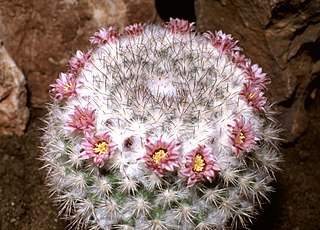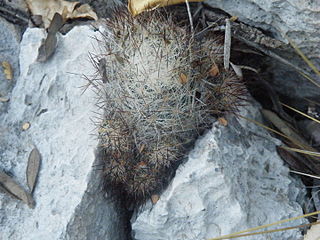
Mammillaria is one of the largest genera in the cactus family (Cactaceae), with currently 200 known species and varieties recognized. Most of the mammillaria are native to Mexico, but some come from the southwest United States, the Caribbean, Colombia, Venezuela, Guatemala and Honduras. The common name "pincushion cactus" refers to this and the closely related genus Escobaria.

Cochemiea is a genus of cactus. The group was previously synonymized with Mammillaria, until molecular phylogenetic studies determined that—when broadly circumscribed—Mammillaria is not monophyletic; thus, Cochemiea has been accepted as a distinct genus.

Pelecyphora, pincushion cactus or foxtail cactus is a genus of cacti, comprising 20 species. They originate from Mexico and the United States.

Cacteae is a tribe of plants of the family Cactaceae found mainly in North America especially Mexico. As of August 2018, the internal classification of the family Cactaceae remained uncertain and subject to change. A classification incorporating many of the insights from the molecular studies was produced by Nyffeler and Eggli in 2010. The main threats to cactus species are poaching, farming, mining developments, and climate change.

Pelecyphora missouriensis, the Missouri foxtail cactus and formerly Coryphantha missouriensis, is a species of low-growing North American cacti.

Pelecyphora vivipara is a species of cactus known by several common names, including spinystar, viviparous foxtail cactus, pincushion cactus and ball cactus. It is native to North America, where certain varieties can be found from Mexico to Canada. Most of these varieties are limited to the Mojave and Sonoran Deserts. The species epithet "vivipara" is due to the species' viviparous reproductive habit.

Pelecyphora minima is a rare species of cactus known by the common names Nellie cory cactus, Nellie's pincushion cactus, birdfoot cactus, and others. It is a very popular species among cactus collectors. This is one reason why it is a highly endangered species in the wild today. This cactus is found only in Brewster County, Texas, in the United States, where there are three populations remaining near Marathon. The cactus is limited to one outcrop in the Marathon Uplift, where it grows in rocky novaculite soils. It was added to the endangered species list in 1979.

Pelecyphora sneedii is a rare species of cactus known by the common names Sneed's pincushion cactus and carpet foxtail cactus. It is endemic to the Chihuahuan Desert of the southwestern United States and northwestern Mexico. It is a small, variable cactus with a lengthy taxonomic history, and is often subdivided into a number of subspecies or varieties. It is usually found on steep, rocky habitats, primarily of limestone geology, in desert scrub or coniferous forest. A species of conservation concern, P. sneedii faces threats from poaching, urban encroachment, and wildfires.

Pelecyphora macromeris, the nipple beehive cactus, is a species of cactus in the United States and Mexico. In the Chihuhuan Desert, it is common and has a wide range.

Pelecyphora tuberculosa, the corncob cactus, is a species of flowering plant in the family Cactaceae, native to the south-central United States, and northern Mexico.

Pelecyphora cubensis is a species of flowering plant in the family Cactaceae, native to Cuba.

Pelecyphora laredoi is a species of flowering plant in the family Cactaceae, native to Mexico.

Pelecyphora hesteri is a species of flowering plant in the family Cactaceae, native to Texas, United States.

Pelecyphora dasyacantha is a species of flowering plant in the family Cactaceae, native to the Mexico.

Pelecyphora emskoetteriana is a species of flowering plant in the family Cactaceae, native to the Mexico and southern United States.
Pelecyphora zilziana is a species of flowering plant in the family Cactaceae, native to Mexico.

Pelecyphora lloydii is a species of flowering plant in the family Cactaceae, native to Mexico.
Pelecyphora duncanii is a species of flowering plant in the family Cactaceae, native to the southern United States.
Pelecyphora abdita is a species of flowering plant in the family Cactaceae, native to the Mexico.

Pelecyphora robbinsiorum known by the common names Cochise pincushion cactus and Cochise foxtail cactus is a species of flowering plant in the family Cactaceae.



















